Gas Heater Safety Media Links
Carbon Monoxide Safety
- Carbon monoxide (CO) is a colorless, odorless, and tasteless gas.
- It is toxic and in closed environments and can easily rise to lethal levels.
- People die each year from carbon monoxide produced by faulty gas heaters.
- Gas heater CO faults are usually arise from non serviced gas heaters or heaters that do not comply with manufacture or Australian Standards for installation or operation.
- It is critical that gas heaters are tested and the results recorded by a licensed gas fitter for combustion spillage every 2 years, after servicing or repairs, or after alterations to the building that may negatively impact the buildings ventilation, including the installation of exhaust fans.
- To evaluate the condition of your heater our technicians follow procedures set out by a combination of manufacturer recommendations and Australian Standards. Technologies such as pressure, temperature air flow and air analysis and other specific tests are utilised to evaluate the condition of your gas heater.
- All measurements and analysis is documented in every gas heater service schedule.
- The ultimate goal is to perform a regular (2 yearly) service test for Carbon Monoxide emissions. Regular servicing is cost-effective and hopefully catches problems before they happen. This approach results in safety, a reduction in unplanned downtime and eliminates elevated costs due to failure of your heater.
Gas Heater Safety Tips, FAQ & Links
Most frequent questions and answers
Carbon monoxide is a colourless, odourless, tasteless and highly poisonous gas that is produced when natural gas or LPG burns. The human body doesn’t recognise when carbon monoxide is present, which means it can easily kill you – it’s often called ‘the silent killer’ for this reason.
Using gas appliances safely means they should only produce a small, safe amount of carbon monoxide.
Faulty or poorly maintained gas appliances present a very high risk of causing carbon monoxide poisoning of the people in your home.
If you have a gas appliance in your home, or you are a landlord who rents out homes with indoor gas appliances, ensure they are serviced every two years to minimise the risk of faults occurring.
Symptoms
Symptoms of carbon monoxide poisoning may occur while using a gas appliance, or immediately after using one. Be aware of:
- persistent tiredness and sleepiness
- shortness of breath
- mild and severe headaches
- nausea
- vomiting
- weakness
- confusion
- loss of consciousness.
Are you being affected by Carbon Monoxide?
If you feel all right when you are out in the fresh air but experience any of the symptoms listed above when using a gas appliance or heater in your home, seek immediate medical attention and tell your doctor that you suspect carbon monoxide poisoning.
To determine if there is any carbon monoxide in your blood, the doctor will need to do a blood test. If the results confirm there is carbon monoxide in your blood, stop using your gas appliances at home immediately and organise for a licensed gas fitter to check and service them.
Extreme carbon monoxide poisoning may lead to confusion, loss of consciousness (this can occur quickly if the level of carbon monoxide is high) and even death.
Some people are especially sensitive or susceptible to carbon monoxide poisoning including:
- people with heart disease
- people with anaemia
- young children
- pregnant women and their unborn babies
- the elderly.
Treating someone with Carbon Monoxide poisoning
To treat a person who is suffering from carbon monoxide poisoning, move them to a well ventilated, gas-free area. Call emergency services on 000 and start the DRSABCD resuscitation procedure, being careful not to inhale the air coming out of the patient.
Exposure limits and testing
If you are concerned about carbon monoxide levels in your home, workplace or any other area, contact a licensed gas fitter to test the levels for you.
The Australian Government Department of Environment and Energy provides health guidance on safe exposure levels of carbon monoxide, which includes an eight-hour time weighted average exposure limit in the workplace of 30 parts per million (ppm) (34 mg/m3).
Gas leaks can be extremely dangerous. Gas has a strong smell added to it so that leaks can be easily detected. If you smell gas don’t ignore it.
If there is a gas fire
Move to a safe location and call 000.
If you smell gas outdoors
If you smell gas in the street or between the street and your gas meter, report the leak immediately on 1800 GAS LEAK (1800 427 532).
Australian Gas Networks is responsible for work on your gas meter and the gas distribution network (eg street mains and pipework connecting the mains to your meter), and are responsible for repairing leaks in these places.
On your property, after the gas meter
If you smell gas on your property after the gas meter, and can access your gas meter safely, turn your gas supply off. If you’re certain the leak is on your property, phone a licensed gas fitter.
Property owners are responsible for ensuring a licensed gas fitter carries out any work from the gas meter outlet up to and including:
- pipe work from the gas meter to appliances
- gas appliances
- any flues or ducts.
An intermittent gas smell could also indicate a leak. If the gas pipe runs underground, other signs may include bubbles on the surface of puddles or patches of dead grass or vegetation.
If you smell gas inside
If you think there’s a gas leak your home:
- don’t use a flame to try and find it
- go outside immediately, opening doors and windows and extinguishing any open flames as you go
- don’t use a fan to assist ventilation
- don’t plug in or unplug any electrical appliances or switch them on or off
- don’t use a telephone, flashlight or switch any lights on or off inside the home, as these could cause a spark and start a fire
- don’t smoke or light matches in or near the property
- locate and turn off the gas and electricity supply to the home, if the meters are outside and it’s safe for you to do so
- use a mobile phone outside or ask a neighbour if you can use their phone to call a licensed gas fitter
- don’t re-enter your home until it has been inspected by a licensed gas fitter and they have confirmed it’s safe.
Gas is a safe and reliable fuel if you use it correctly. However, using gas or gas appliances incorrectly can cause fires, injury and even death.
- Only buy or use Australian safety tested and certified gas appliances.
- Make sure any permanent gas appliances are installed by a licensed gas fitter.
- Always read and follow the manufacturer’s instructions.
- Make sure the gas appliance has adequate ventilation to operate properly and prevent the build-up of toxic gases, particularly in small areas, such as caravans where doors and windows are tightly sealed.
- Only use gas appliances for their designated purpose, eg never use a gas stove to heat a room, as it’s not designed to operate safely for that purpose.
- Only use the correct gas type for the appliance, eg if an appliance is designed to use natural gas, it is very dangerous to run it using LPG.
- If you have gas appliances in your home or you are a landlord who rents out homes with indoor gas appliances, have them serviced every two years by a licensed gas fitter. Also, ask the gas fitter to check the appliances are safely installed.
- For flued gas appliances, regularly check the flue is clear and not corroded. If it’s damaged, call a licensed gas fitter to get it repaired so dangerous toxic gases don’t build up in your home.
- Watch out for signs that the gas isn’t burning properly. Signs include:
- a rotten-egg smell and eye irritation
- soot or yellow-brown stains on or around the appliance
- a pilot light that keeps blowing out
- changes in gas flame colour – a gas flame is normally blue, so if it turns yellow it normally means an increase in the amount of carbon monoxide being produced.
- Teach children not to play with the controls of a gas appliance or light a gas appliance without adult supervision.
- Never use or store combustible materials near gas appliances, including aerosols, laundry and cleaning products, paper, paint, curtains, clothing, bedding or flammable liquids.
- Never leave a heater unattended – if a fire starts while you’re asleep or away from your home, it could become out of control before you’re able to respond.
- Make sure portable heaters are kept upright at all times and not where they could be knocked over. Avoid putting them on table tops, unless they’re designed for that purpose, as the heat could damage the table or they could fall off and start a fire.
- If using solvent-based paints in a small, poorly ventilated space, turn off any gas appliances in the room until the paint is dry and the solvent smell has disappeared.
- If using an insect bomb to fumigate your house, read and strictly follow the manufacturer’s instructions on the packaging. The propellant in these products is normally flammable and the vapours may be ignited by a gas appliance burner, pilot light or other ignition sources.
- Make sure you read and understand the manufacturer’s instructions for your gas appliances before turning them on and lighting any pilot lights.
- If a licensed gas fitter has just installed a new appliance for you, ask them to show you how to use it properly.
- If you’re using a match or lighter to light a gas appliance, light the match or lighter before turning on the gas. If the gas doesn’t light or your flame goes out, turn off the gas and wait a few minutes before trying again.
- If your appliance won’t light
- Check your gas supply is turned on before calling a licensed gas fitter to have it checked
- If the appliance is under warranty, call the retailer or manufacturer
- If your gas supply won’t turn on, contact your gas supplier.
- If the gas supply company isolated your gas supply, they’ll help you restore the gas and relight your appliances. If you’re not home when they come to help, they’ll leave a brochure to guide you through the steps for relighting appliances.
- If your gas supply has been turned off and back on again, air can get trapped in the gas pipes in your home. The first appliance you light will purge any trapped air but may take a few moments to light while the gas flows from the meter. If there is air in the pipework, the appliance you light may go out shortly after. Turn it off, wait a few minutes for the unburnt gas to disperse, then try to light the appliance again. Once it is lit, let it burn for at least three minutes so the gas is flowing properly. Gas cooktops are the easiest appliances to light first, if you have one.
If you are using an outdoor appliance in an area that is partially enclosed, such as a verandah, courtyard or gazebo, ensure it has adequate ventilation.
Natural gas and LPG require a certain amount of oxygen to burn correctly, but inadequate ventilation of gas appliances can create a serious health hazard.
Every cubic metre of natural gas needs 10 cubic metres of air for complete combustion. LPG requires 24 cubic metres of air. Too little air causes incomplete combustion which produces carbon monoxide.
To protect your health and safety, always make sure the people in your home understand how to use gas appliances safely.
Most indoor gas appliances use air within the room for the oxygen they need to burn gas. If the room doesn’t have enough ventilation to allow fresh air into the room, the amount of oxygen available will be depleted and other gases will build up.
Indoor gas appliances are designed and tested to operate safely in an indoor environment. They may be power flued, natural draught flued or unflued appliances.
Power flued appliances draw air from within a room and then use a fan or other powered system to push air and combustion products outside. Natural draught flued appliances use a chimney to draw air outside. Unflued appliances use air within a room and expel their combustion products into the same room.
Unflued and natural draught flue systems should not be installed in small rooms (eg bathrooms) or rooms used for sleeping, due to the risk of toxic levels of carbon monoxide building up. When flued systems are installed in other rooms, they must have permanent ventilation to outside.
Flued gas appliances have fixed duct work, piping or chimneys to vent combustion products outside. Make sure the flue is not obstructed or blocked and that there are no holes in the flue before using the appliance.
Regularly inspect your gas appliance. Discolouration or stains on your walls or on the appliance, or moisture forming on the inside of your windows may be signs of a blocked flue.
If you think an appliance is faulty, contact a licensed gas fitter to inspect and service the appliance before you use it.
A room sealed gas instantaneous water heater has a flue that is partitioned to provide both air to the appliance while separately expelling the combustion gases outside. This is the only type of gas instantaneous water heater that can be installed in a bathroom or room with limited ventilation.
Unflued gas appliances have no direct way of venting combustion products outside, so it is vital that the room has adequate permanent ventilation to maintain safe air quality, prevent mould growth (due to moisture in the air), and to ensure the appliance can function properly.
By law, any room that has an unflued gas space heater installed must also have two permanent ventilation openings to outside the home – one at ceiling level and one at floor level. Each opening must have a minimum area of 1,000 square millimetres per megajoules per hour (MJ/h), based on the maximum gas consumption level of the heater. See below for restrictions on unflued gas space heaters approved for use in South Australia.
If you are using an unflued gas appliance indoors, never seal doors, windows, skylights or ventilation grilles while the appliance is running.
If you are purchasing an unflued gas appliance:
- make sure it is safety tested and certified in Australia
- be wary of buying gas space heaters online – safety standards for gas space heaters vary across Australia, so something from interstate or overseas may not comply with South Australian legislation or Australian safety standards
- ensure you fully understand how much permanent ventilation is required for the appliance to be compliant and safe if you are purchasing it directly from a supplier
- purchase from a reputable gas product seller, such as an energy retailer or gas heating specialist, who can help you choose the most suitable heater for your room.
Never use an unflued gas appliance in a bedroom, bathroom, caravan or marine craft (or any room used for sleeping).
Gas instantaneous water heaters must not be installed in a bathroom or room with limited ventilation unless they are a room sealed type.
Unflued gas space heaters approved for use in South Australia
There are restrictions on the types of unflued gas space heaters that can be installed in South Australian homes.
Before choosing and installing an unflued gas space heater, speak to a licensed gas fitter to ensure the heater is appropriate for the size and type of room, and there is adequate ventilation in the room it will be heating.
Portable unflued gas space heaters with a capacity of less than 18 MJ/h can be installed in South Australia, regardless of fuel type (ie LPG or natural gas). When the maximum gas consumption level of the unflued gas space heater is more than 18MJ/h, the system must have additional safety features. The table below lists systems consuming more than 18 MJ/h approved for use in South Australia.
Before turning your gas supply off or on, make sure you first turn off all gas appliances and pilot lights in your home, eg gas cooking appliances, heaters, and water heaters. If you have a gas water heater, turn the water supply tap off, too.
Natural Gas Supply
Locate your gas meter – it may be in a metal box on the side of your house, or in your front garden under a plastic cover.
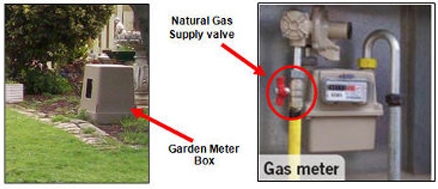
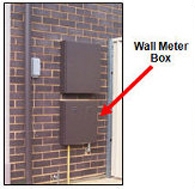
To turn off the gas supply into your home, turn the supply valve tap to the horizontal off position (at a right angle to the pipe). To turn it on, turn the supply valve tap to the vertical on position (in line with the pipe).
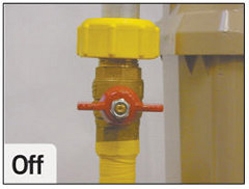
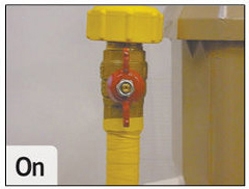
If you don’t know where your gas meter or supply valve is, contact your gas provider.
LPG Gas Supply
Locate your LPG cylinder(s). In most cases, it will be installed on a concrete slab against or near the house.
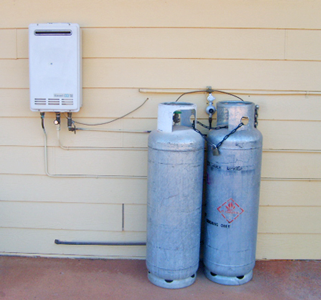
To turn off the gas supply into your home, turn the round valve at the top of the cylinder in a clockwise direction until it won’t turn anymore. If you have more than one cylinder, make sure you turn them both off. To turn the gas supply on, turn the valve anti-clockwise.
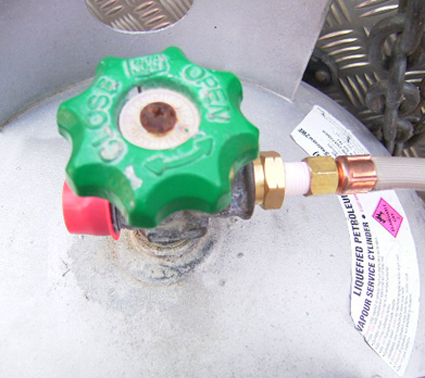
- Make sure you read and understand the manufacturer’s instructions for your gas appliances before turning them on and lighting any pilot lights.
- If a licensed gas fitter has just installed a new appliance for you, ask them to show you how to use it properly.
- If you’re using a match or lighter to light a gas appliance, light the match or lighter before turning on the gas. If the gas doesn’t light or your flame goes out, turn off the gas and wait a few minutes before trying again.
- If your appliance won’t light
- Check your gas supply is turned on before calling a licensed gas fitter to have it checked
- If the appliance is under warranty, call the retailer or manufacturer
- If your gas supply won’t turn on, contact your gas supplier.
- If the gas supply company isolated your gas supply, they’ll help you restore the gas and relight your appliances. If you’re not home when they come to help, they’ll leave a brochure to guide you through the steps for relighting appliances.
- If your gas supply has been turned off and back on again, air can get trapped in the gas pipes in your home. The first appliance you light will purge any trapped air but may take a few moments to light while the gas flows from the meter. If there is air in the pipework, the appliance you light may go out shortly after. Turn it off, wait a few minutes for the unburnt gas to disperse, then try to light the appliance again. Once it is lit, let it burn for at least three minutes so the gas is flowing properly. Gas cooktops are the easiest appliances to light first, if you have one.
All information provided here is available by following the SA GOV links above.
contact us
Need an expert? You are more than welcome to leave your contact information and we will be in touch shortly.